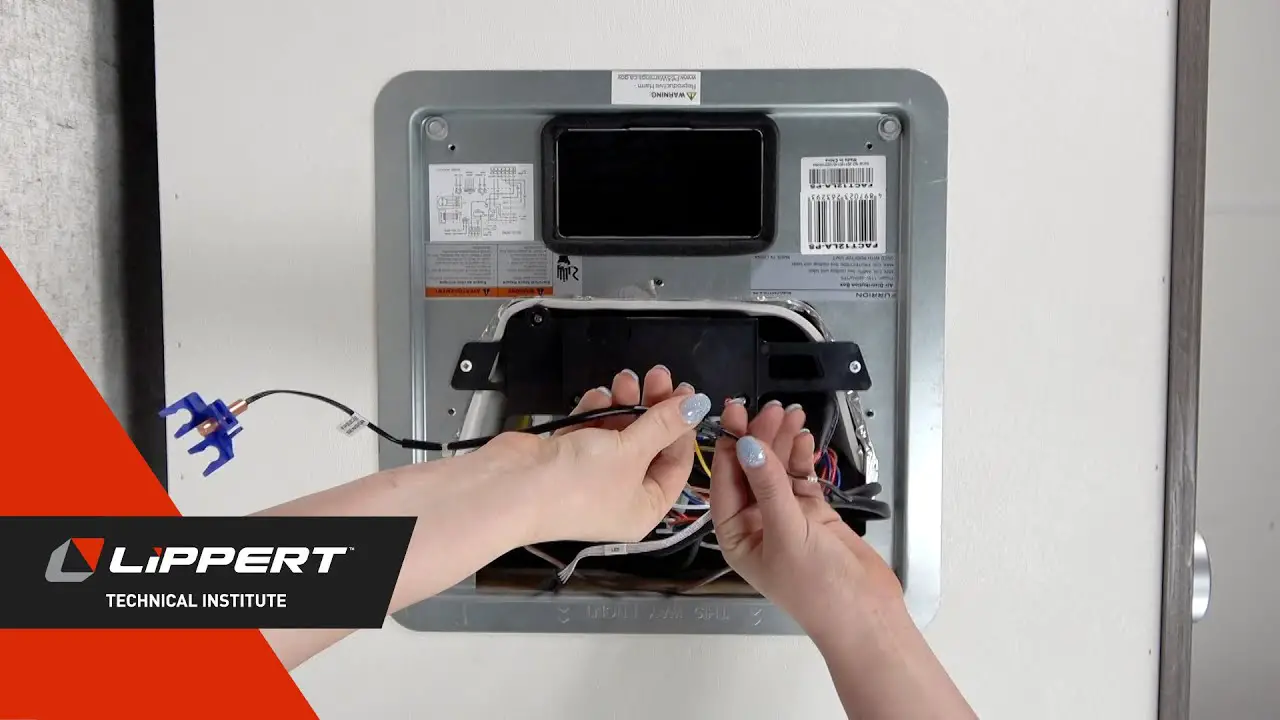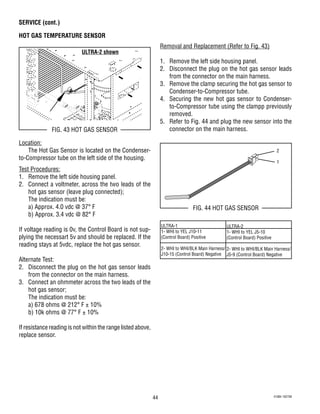The Dometic RV AC freeze sensor is typically located near the evaporator coils for monitoring temperature. It helps prevent the freezing of the AC unit.
For RV owners, ensuring the proper functioning of the AC system is crucial for a comfortable travel experience. The freeze sensor plays a key role in detecting temperature changes within the unit, triggering a shutdown to prevent freezing. Understanding its location and how it operates can help maintain the efficiency and longevity of the RV AC system.
Regularly checking and cleaning the freeze sensor can help avoid malfunctions and ensure optimal performance during your travels. Let’s explore more about the significance of the freeze sensor and its impact on RV AC functionality.

- Understanding Rv Air Conditioning System
- Common Locations For Rv Ac Freeze Sensors
- Factors Affecting Sensor Location
- Tips For Finding The Freeze Sensor
- Importance Of Regular Maintenance
- Alternative Solutions When Location Is Unknown
- Frequently Asked Questions For Dometic Rv Ac Freeze Sensor Location
- Conclusion
Understanding Rv Air Conditioning System
In recreational vehicles (RVs), air conditioning plays a crucial role in maintaining a comfortable living environment. The RV air conditioning system comprises various components working together to regulate the interior temperature.
Components Of Rv Ac System
The RV air conditioning system includes a compressor, evaporator, condenser, thermostat, and air ducts to circulate cool air throughout the vehicle.
Role Of Freeze Sensor In Ac System
The freeze sensor in the RV AC system acts as a safety mechanism to prevent the unit from freezing up during operation. When the sensor detects potential freezing, it triggers the system to adjust its settings to avoid damage.

Credit: www.amazon.com
Common Locations For Rv Ac Freeze Sensors
RV AC freeze sensors are strategically placed in certain locations within the air conditioning system to detect and prevent freezing issues. Let’s explore these common locations:
Inside The Air Handler Unit
The freeze sensor can be found inside the air handler unit, which is typically located within the RV. It monitors the temperature to prevent freezing.
Near The Evaporator Coils
Another common location for the freeze sensor is near the evaporator coils. These coils play a key role in the cooling process, making it an ideal spot to detect freezing.
In The Ductwork
The freeze sensor may also be placed in the ductwork of the RV AC system. This ensures that the sensor can detect any potential freezing throughout the ducts.
Factors Affecting Sensor Location
Optimal Dometic RV AC freeze sensor location directly impacts overall efficiency and performance. Placing the sensor correctly ensures early detection and prevention of potential freezing issues, enhancing the unit’s lifespan and functionality. Strategic sensor placement is crucial for effective temperature monitoring in your RV AC system.
Factors Affecting Sensor Location When it comes to the location of the freeze sensor in your Dometic RV AC unit, several factors play a crucial role. Understanding these factors can help you ensure optimal performance and efficient functioning of your RV air conditioning system.Type Of Rv Ac Unit
The type of RV AC unit you have installed can greatly influence the location of the freeze sensor. Whether it’s a ducted or non-ducted system, rooftop or built-in unit, each type may require a different sensor placement to effectively monitor and prevent freezing of the evaporator coil.Manufacturer Variations
Manufacturer variations in RV AC units can also impact the placement of the freeze sensor. Different brands and models may have specific recommendations regarding the sensor location based on the design and airflow patterns of the unit. Understanding the manufacturer’s guidelines is essential to ensure proper functioning and avoid any potential issues with the freeze protection system. In addition, installation variations among different units can also determine the ideal sensor location. Factors such as the layout of the RV interior, proximity to airflow obstructions, and accessibility for maintenance can all influence where the freeze sensor should be positioned for optimal performance.
Credit: m.youtube.com
Tips For Finding The Freeze Sensor
When it comes to maintaining your RV’s air conditioning system, finding the freeze sensor is crucial. The freeze sensor is responsible for detecting if the AC unit is at risk of freezing, which can cause serious damage. In this section, we will explore some useful tips for locating the freeze sensor in your Dometic RV AC unit.
Consulting The Manual
One of the simplest ways to find the freeze sensor in your Dometic RV AC unit is by consulting the user manual. The manual provides detailed information about different components of the AC system, including the freeze sensor. You can typically find the freeze sensor’s location and other relevant details in the manual’s troubleshooting or maintenance section.
Visual Inspection
If you don’t have access to the user manual or prefer a hands-on approach, a visual inspection is an excellent method for finding the freeze sensor. Here are some steps to guide you through the process:
- Turn off the power to the RV’s AC unit for safety.
- Locate the main control panel for the AC unit, usually found in the RV’s interior.
- Inspect the control panel and look for any labeled components or indicators related to the freeze sensor.
- If you can’t find any visible signs of the freeze sensor on the control panel, move on to examining the AC unit’s exterior.
- Check the exterior of the AC unit for any sensors or wires that could be connected to the freeze sensor.
Keep in mind that the freeze sensor’s location may vary depending on the specific model of your Dometic RV AC unit. Therefore, it’s essential to pay close attention to any labels or indicators that may guide your search.
Once you successfully locate the freeze sensor, you can take note of its position for future reference. It’s also a good idea to ensure the sensor is clean and free from any debris or obstructions that could affect its functionality. Regularly checking and maintaining the freeze sensor will contribute to the overall efficiency and longevity of your RV’s air conditioning system.
Importance Of Regular Maintenance
Regular maintenance of your Dometic RV AC unit is crucial in preventing freezing and damage, as well as extending its lifespan. By taking proactive measures, you can ensure that your AC system continues to function optimally, providing you with comfort during your travels. Let’s explore why regular maintenance is so important for your Dometic RV AC unit.
Preventing Freezing And Damage
One of the main reasons to prioritize regular maintenance for your Dometic RV AC unit is to prevent freezing and potential damage. Over time, dust, debris, and other particles can accumulate in the AC unit, obstructing the airflow and reducing its efficiency. This restricted airflow can lead to the formation of ice on the evaporator coil, causing the AC to freeze up. The freeze sensor, which plays a crucial role in detecting low temperatures and preventing freezing, is typically located near the evaporator coil.
Regular maintenance tasks such as cleaning or replacing air filters, ensuring proper ventilation, and inspecting the overall condition of the AC unit help to keep the system running smoothly. By doing so, you reduce the risk of freezing and subsequent damage to your Dometic RV AC unit.
Extending Ac Lifespan
Caring for your Dometic RV AC unit through regular maintenance not only prevents freezing but also extends its overall lifespan. Simple tasks such as cleaning the air filters and removing debris from the condenser coils can significantly improve the efficiency of the unit, reducing the strain on its components.
By minimizing the strain on the AC unit, you can avoid premature wear and tear, which often leads to costly repairs or even the need for a replacement unit. With regular maintenance, you can maximize the lifespan of your Dometic RV AC and ensure that it continues to provide reliable cooling for your RV adventures.
Summary
- Regular maintenance prevents freezing and damage to your Dometic RV AC unit
- Proper maintenance extends the lifespan of your AC, reducing the need for costly repairs or replacements

Credit: www.slideshare.net
Alternative Solutions When Location Is Unknown
When it comes to the Dometic RV AC freeze sensor location, finding it can be quite a challenge, especially for those who are not familiar with the inner workings of the HVAC system. However, there are alternative solutions available when the sensor’s location is unknown. By consulting an HVAC professional or using advanced detection methods, owners can address the issue and ensure their RV’s AC system operates efficiently.
Consulting An Hvac Professional
When dealing with a situation where the freeze sensor location is unknown, seeking the expertise of an HVAC professional can provide valuable insight. These professionals have the experience and knowledge to quickly identify the sensor’s location and offer solutions to any related issues.
Using Advanced Detection Methods
For those who prefer a more hands-on approach, utilizing advanced detection methods can help locate the freeze sensor effectively. Tools such as thermal imaging cameras and electronic leak detectors can aid in pinpointing the sensor’s position within the RV AC system, allowing for targeted troubleshooting and resolution.
Frequently Asked Questions For Dometic Rv Ac Freeze Sensor Location
Where Is The Freeze Sensor Located In A Dometic Rv Ac?
The freeze sensor in a Dometic RV AC is typically located near the evaporator coils. It is designed to detect freezing conditions and prevent damage to the air conditioner. By sensing the temperature, the freeze sensor can trigger the AC to shut off or initiate a defrost cycle to prevent the coils from freezing over.
What Does The Freeze Sensor Do In A Dometic Rv Ac?
The freeze sensor in a Dometic RV AC plays a crucial role in preventing the evaporator coils from freezing over. It monitors the temperature of the coils and if it detects freezing conditions, it will signal the AC unit to shut off or initiate a defrost cycle.
This helps to maintain optimal performance and prevent damage to the AC system.
How Does The Freeze Sensor Protect The Dometic Rv Ac?
The freeze sensor protects the Dometic RV AC by detecting freezing conditions on the evaporator coils and taking necessary action. If it senses that the temperature is dropping below freezing, it will shut off the AC unit or initiate a defrost cycle.
This prevents the coils from freezing over, ensuring proper functionality and preventing damage to the AC system.
Can The Freeze Sensor Be Moved Or Relocated In A Dometic Rv Ac?
The freeze sensor in a Dometic RV AC is typically installed in a specific location near the evaporator coils. It is not recommended to move or relocate the freeze sensor as it is calibrated to function correctly in its original position.
Altering its location may lead to incorrect temperature readings and affect the system’s performance.
Conclusion
Knowing the location of your Dometic RV AC freeze sensor is vital for maintaining optimal performance. By being aware of its placement, you can prevent potential issues and ensure your RV air conditioning system runs smoothly. Check the manufacturer’s guidelines for the precise location and take necessary steps to safeguard your RV’s comfort.